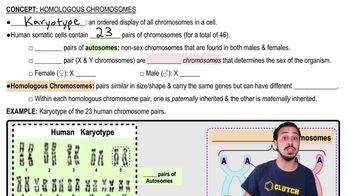Meiosis II is similar to mitosis in that a. sister chromatids separate during anaphase. b. DNA replicates before the division. c. the daughter cells are diploid. d. homologous chromosomes synapse.
DRAW IT The diagram shows a cell in meiosis. a. Label the appropriate structures with these terms: chromosome (label as duplicated or unduplicated), centromere, kinetochore, sister chromatids, nonsister chromatids, homologous pair (use a bracket when labeling), homolog (label each one), chiasma, sister chromatid cohesion, and gene loci, labeling the alleles of the F and H genes.

Verified Solution
Key Concepts
Meiosis

Chromosomes and Chromatids

Genetic Variation and Alleles

If the DNA content of a diploid cell in the G1 phase of the cell cycle is x, then the DNA content of the same cell at metaphase of meiosis I will be a. 0.25x. b. 0.5x. c. x. d. 2x.
If we continue to follow the cell lineage from question 4, then the DNA content of a single cell at metaphase of meiosis II will be a. 0.25x. b. 0.5x. c. x. d. 2x.
DRAW IT The diagram shows a cell in meiosis. b. Describe the makeup of a haploid set and a diploid set.
DRAW IT The diagram shows a cell in meiosis.
c. Identify the stage of meiosis shown.
Assume that genes A and B are on the same chromosome and are 50 map units apart. An animal heterozygous at both loci is crossed with one that is homozygous recessive at both loci. What percentage of the offspring will show recombinant phenotypes resulting from crossovers? Without knowing these genes are on the same chromosome, how would you interpret the results of this cross?
